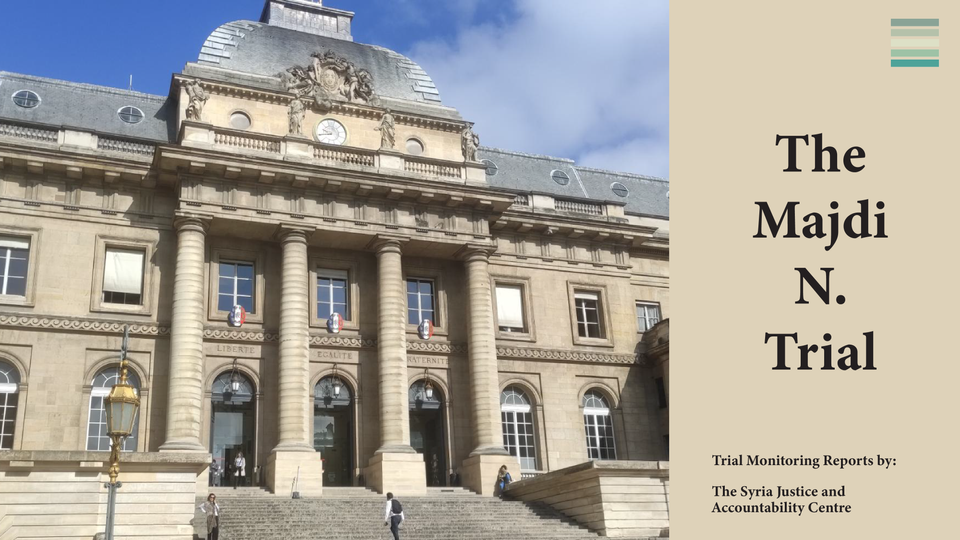
Inside the Majdi N. Trial #12: Testimony of Robert Petit, Head of the IIIM, on the Existence of a Non-International Armed Conflict in Syria
TRIAL OF MAJDI N.
Court of Assize – Paris, France
Trial Monitoring Summary #12
Hearing Date: May 12, 2025
CAUTION: Some testimony may include graphic descriptions of torture, rape or other violent acts.
Note that this summary is not a verbatim transcript of the trial; it is merely an unofficial summary of the proceedings.
Throughout this summary, [information located in brackets are notes from our trial monitor] and “information placed in quotes are statements made by the witness, judges or counsel.” The names and identifying information of witnesses have been redacted.
[Note: SJAC provides a summary of the proceedings while redacting certain details to protect witness privacy and to preserve the integrity of the trial.]
[Note: Rather than publishing the trial reports of the Majdi N. case in chronological order, SJAC has organized them thematically and coherently based on the content of the hearings, making the material more accessible by highlighting key issues and connections across the proceedings.]
SJAC’s 12th trial monitoring report details day 6 (afternoon) of the trial of Majdi N. in Paris, France. On this trial day, W7 explained how the International, Impartial and Independent Mechanism (IIIM) has assessed the existence of a non-international armed conflict in Syria since December 2011 and how the IIIM has determined the authenticity and reliability of evidence.
Day 6 – May 12, 2025
Afternoon Session
Proceedings resumed at 2:10 PM.
The witness, Robert Petit, W7, the head of the International, Impartial and Independent Mechanism (IIIM) was sworn in.
Witness Robert Petit explained that for this case file, the IIIM furnished information pointing to the existence of a non-international armed conflict (NIAC) in Syria and provided OSINT material as well as interviews conducted by the Commission of Inquiry on Syria.
[Situations that qualify as an armed conflict are governed by both treaty and customary rules of International Humanitarian Law (IHL). With the humanitarian aim of curbing the effects of armed conflicts, IHL imposes on the parties to such conflicts the legal obligation to afford certain minimum protections and to limit certain means and methods of warfare. Violation of such rules could entail individual criminal responsibility. Under IHL, there are two types of armed conflicts – international armed conflicts (IAC) and non-international armed conflicts (NIAC). Depending on the classification, different sets of IHL rules would come into effect. The violation of such different rules could be legally characterized differently. In any criminal proceeding related to an armed conflict, therefore, the court must first determine the existence of an armed conflict and classify such conflict to establish the applicable legal framework, thereby accurately characterizing the criminal conduct in question.
In the Syrian case, there is a broad consensus among experts that several NIACs and IACs coexisted starting in 2011. Concerning the specific conflict that took place between the Syrian Government forces and the armed factions, including Jaysh Al-Islam, the IIIM concluded that it constituted a NIAC, resulting in the applicability of Common Article 3 of the 1949 Geneva Conventions, as well as the relevant rules of customary IHL of NIACs. This classification enables the prosecution of alleged perpetrators for certain types of war crimes]
Witness Robert Petit explained that the exists are: first, the intensity of the conflict; and second, the level of organization of the party that opposes the state. To determine the intensity, experts look at the types of instruments used, the number of victims, the international attention given to the conflict, etc. To reach a conclusion on the level of organization, elements such as the command structure, the territorial control by a group, etc., are assessed.
In the context of the Syrian conflict, the IIIM concluded that a NIAC had existed since December 2011. Witness Robert Petit explained that this conclusion was based on the analysis of more than 200 documents from different sources, and he detailed to the Court  and reliability were assessed; regarding authenticity, the IIIM looked at the stamp and signature appearing on the document, the branch which supposedly released it, etc. As for the reliability, the IIIM examined the chain of custody, the methodology used to obtain the evidence and corroborated the evidence with context witnesses' testimonies, open source, etc. He added that, for an act to be considered a crime, it must be connected to the conflict.
Presiding Judge Lavergne questioned Witness Robert Petit about the methodology used to define a NIAC. Civil Parties’ Counsel Bailly inquired about links between the IIIM and ongoing investigations by national courts, to which Witness Robert Petit replied that they were confidential. Responding to Prosecutor Thouault, Witness Robert Petit explained how to assess that a crime was connected to a NIAC.
Defense Counsel Boxelet inquired about Witness Robert Petit’s visit to Syria in early 2025 and contended that the IIIM was acting as a database without necessarily providing guarantees on reliability of evidence. Witness Robert Petit rejoined by repeating how they assessed the authenticity and reliability of evidence. Regarding anonymous testimonies, Witness Robert Petit asserted that the IIIM used anonymization methods to ensure both the validation of the witness's identity and his safety. Counsel Boxelet asked Witness Robert Petit if the IIIM would have shared documents related to Majdi N. if they had any, which Witness Robert Petit confirmed. Counsel Kempf concluded that after many years of investigation, the IIIM did not find any interview related to Majdi N.
Proceedings were suspended at 3:50 PM.
___________________________
For more information or to provide feedback, please contact SJAC at [email protected] and follow us on Facebook and Twitter. Subscribe to SJAC’s newsletter for updates on our work